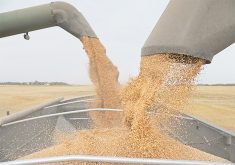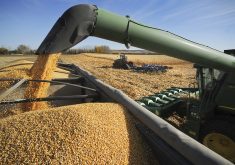Josh Linville gave farmers at Ag in Motion lots of insight into the geopolitical factors explaining why fertilizer prices are so high, explosive and unpredictable.
But after doing that, he offered his most valuable advice for growers:
“Our big thing is if you purchase inputs, sell some grain. If you sell grain, purchase inputs,” said Linville, the chief fertilizer market analyst with StoneX, an American commodity trading firm.
“Doing both sides is hedging.”
Essentially, Linville was telling farmers to ignore all his insight about Lithuania, Belarus, China, Russia, Trinidad, the United States and other fertilizer players and instead focus on locking in profits.
Read Also

Why feds imposed EV tariffs
Moe and Kinew have a fight on their hands when it comes to eliminating the EV tariff. Canada has to worry about pissing off the U.S. and Mexico and hundreds of thousands of auto workers.
“If your worst decision for this year’s crop or next year’s crop results in a profit, it’s a good year, guys.”
Although hedging is always a good idea for at least a portion of a commodity production company such as a farm, in which most of the profits come from the spread between cost of production and sales revenue with the two often diverging unpredictably, Linville is particularly cautious about forecasting market direction today.
This isn’t because of the inherent volatility in commodity markets due to supply and demand fundamentals. That’s been around forever. It comes from the outright political interference in fertilizer markets by multiple governments right now. How do you predict potash prices when a major world exporter, Belarus, might be cut off from world markets, or might not be?
How do you predict Chinese fertilizer exports when the Chinese government, the furthest thing from a transparent entity, might continue to restrict exports, or might not, or might do something else out of the blue?
How do you forecast fertilizer and grain exports when much of the world’s tradeable supplies during the raging war in Ukraine and Black Sea?
“A lot of the biggest factors that are going to drive fertilizer markets are international and they are being driven by governments,” said Linville.
“They are not being driven by fundamentals as the fertilizer markets.”
Fertilizer costs make up a major portion of the cost of production of most crops. Never before have farmers invested so much in crop and seldom have prices offered such tantalizing rewards. Farmers could make the biggest profits of their lives this year or face the greatest losses.
For gamblers, that’s a fun scenario to play with.
For cautious business operators, it’s smart to avoid ending up on the wrong side of the wager.
“If you’re buying fertilizer, sell some grain. If you’re selling some grain, buy some diesel fuel,” said Linville.
“It’s both sides of the equation. My biggest fear for the farmers across North America is that we buy fertilizer and the price of grain drops by half, or that we sell grain and all of a sudden the price of fertilizer doubles again.”
It’s tempting this year to look at world geopolitics, world weather reports and local conditions and figure this is a perfect time to swing for the bleachers. But Linville pointed out that it’s hard to hit that whizzing fastball and there’s a heavy cost to striking out.
“We want to be hitting singles. We want to bunt for base,” said Linville.
It might feel unexciting to play cautiously in these historic times of volatility, huge costs and high prices, but sometimes being dull is the only smart bet.
















